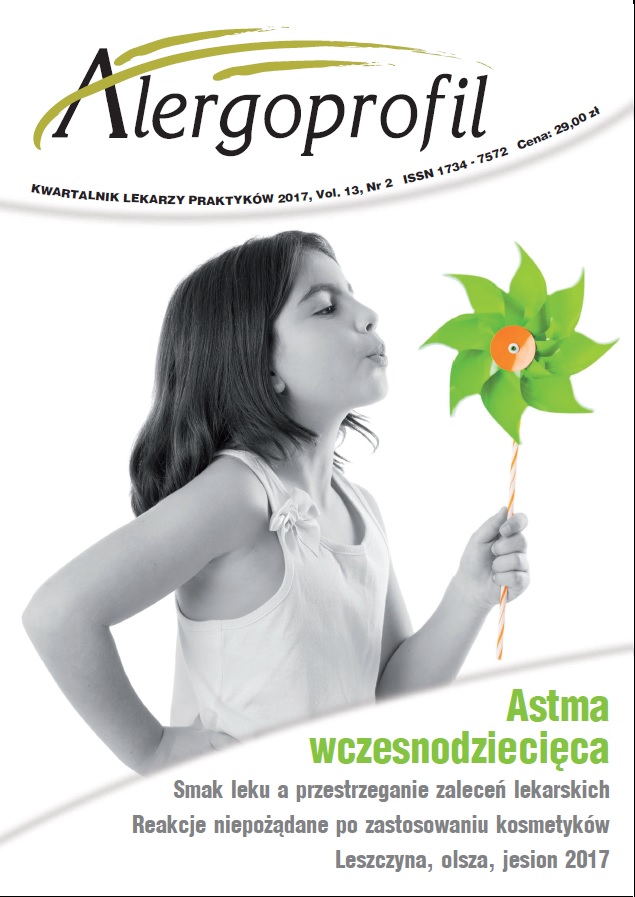Pyłek olchy w północnej Polsce w 2017 r.
##plugins.themes.bootstrap3.article.main##
Abstrakt
Tree pollens are responsible for type I allergies during the flowering season in late winter and early spring. Pollen grains from e.g. alder constitute the important allergen sources in this respect in the northern hemisphere. The aim of the study was to investigate the concentration of alder (Alnus spp.) in Szczecin, Drawsko Pomorskie, Bydgoszcz, Olsztyn, Warsaw and Bialystok in 2017. In northern Poland, the genus Alnus Mill. is represented by only 2 species, A. glutinosa (L.) Gaertner and A. incana (L.) Moench. Measurements were performed by the volumetric method (Burkard and Lanzoni pollen samplers). Pollen season was defined as the period in which 98% of the annual total catch occurred. Seasonal Pollen Index (SPI) was estimated as the annual sum of daily average pollen concentrations. The pollen season of alder started first in Szczecin, on the 21st February and also in Bialystok and Drawsko Pomorskie on the 22nd February (only one day later). This pollen season lasted till the 3rd April in Bialystok. The differences of pollen seasons duration ware not considerables. The highest, record airborne concentration of 1215 pollen grains/m3 was noted in Szczecin on the 4th March and in Warsaw, Drawsko Pomorskie, Bydgoszcz and Olsztyn on the 5th of March. The peak values of seasonal pollen count occurred between 4th and 22nd March in all cities.
Pobrania
##plugins.themes.bootstrap3.article.details##
Copyright: © Medical Education sp. z o.o. This is an Open Access article distributed under the terms of the Attribution-NonCommercial 4.0 International (CC BY-NC 4.0). License (https://creativecommons.org/licenses/by-nc/4.0/), allowing third parties to copy and redistribute the material in any medium or format and to remix, transform, and build upon the material, provided the original work is properly cited and states its license.
Address reprint requests to: Medical Education, Marcin Kuźma (marcin.kuzma@mededu.pl)
Bibliografia
2. Bremer B, Bremer K, Chase M. An update of the Angiosperm Phylogeny Group classification for the orders and families of flowering plants: APG III. Bot J Linean Soc 2009, 161(2): 105-121.
3. Mothes N, Valenta R. Biology of tree pollen allergens. Curr Allergy Asthma Rep 2004, 4(5): 384-390.
4. Heinzerling LM, Burbach GJ, Edenharter G et al. GA(2)LEN skin test study I: GA(2)LEN harmonization of skin prick testing: Novel sensitization patterns for inhalant allergens in Europe. Allergy 2009, 64(10): 1498-1506.
5. Rapiejko P, Lipiec A, Wojdas A et al. Threshold pollen concentration necessary to evoke allergic symptoms. Int Rev Allergol Clin 2004, 10(3): 91-93.
6. Nilsson S, Persson S. Tree pollen spectra in the Stockholm region (Sweden) 1973-1980. Grana 1991, 20: 179-182.
7. González-Parrado Z, Fuertes-Rodríguez CR, Vega-Maray AM et al. Chilling and heat requirements for the prediction of the beginning of the pollen season of Alnus glutinosa (L.) Gaertner in Ponferrada (León, Spain). Aerobiologia 2006: 22-47.
8. Zając A, Zając M (ed.). Distribution Atlas of Vascular Plant of Poland. Pracownia Chorologii Komputerowej Instytutu Botaniki UJ, Kraków 2001.
9. Lipiec A, Puc M, Rapiejko P et al. Alder pollen in the air of selected Polish cities in 2015. Alergoprofil 2015, 11(2): 45-52.
10. Puc M, Rapiejko P, Lipiec A et al. The analysis of alder pollen season in northern Poland in 2016. Alergoprofil 2016, 12(2): 92-96.
11. Weryszko-Chmielewska E (ed.). Pyłek roślin w aeroplanktonie różnych regionów Polski. Kat. i Zakład Farmakognozji Wydz. Farmaceutycznego Akademii Medycznej, Lublin 2006.

